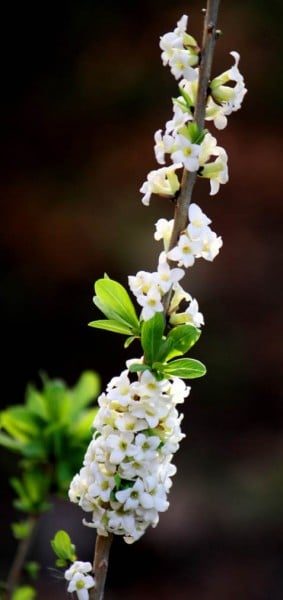In my Zone 6a garden, February daphne (Daphne mezereum, Zone 5) blooms in March. The calendar discrepancy causes me no concern, because they’re still the earliest of deeply scented shrubs (soon to be followed by Koreanspice viburnum and lilacs), and reward me for braving the elements when I’m out early to get things done. When temperature and humidity are just right, the daphne sends waves of perfume (similar to hyacinth scent) across the garden and right up to the front door, a knockout encounter when picking up the morning papers from the doormat. I wouldn’t be surprised to find the newspaper delivery person sitting on the step to enjoy the moment!

February daphne grows three to five feet (90 cm to 1.5 m) tall and wide, and likes light shade to full sun. Its upright, vertical branches carry clusters of small flowers, mostly along the upper third, and are long lasting in cool spring air. Easiest to find is the purple-pink colour, and I have a one growing in the front garden. But around the corner in the air-conditioner bed, I have a white February daphne (D. m. f. alba), which has cream flowers with yellow shading in their throats. It’s every bit as lovely as the purple, and has some named cultivars of its own, but it’s not often you see a white one for sale. In fact, if you see either colour, you’d be smart to grab it. Daphne mezereum isn’t widely available, but usually can be found with a bit of scouting around specialty plant nurseries and asking for it.
Most often the February daphnes for sale are small, but they grow quickly, and their medium to light green foliage is attractive all summer. They require little more than consistently moist organic soil. The plants have soft wood, and that may be partially the cause for a sudden and fatal virus that can afflict them. I’ve had three February daphnes and one, grown in light shade, contracted the virus. (My personal theory is that growing in a site with some direct sun may make healthier and slightly harder wood.) But that loss hasn’t discouraged me, as February daphne is just too beautiful to be without.
When the flowers are finished, prominent (and toxic) bright red seeds appear from purple flowers, and yellow seeds from white flowers. The seeds are quite decorative and should be left in place. In another year you may find seedlings, recognizable by their foliage, and by actual flowers on two-year-old plants. You won’t get a flood of seedlings, just enough to be happy about the discovery.
If you want to try starting new plants from seed, collect the bright berries in midsummer, when they begin to fall off. The seed coat contains germination inhibitors and must be removed while still soft; if it dries on the seeds, germination will be a long and challenging procedure. When the seeds are cleaned of their coats, soak them in water for five days (changing the water each day), and then plant in containers or in the garden where you want them to grow. I once forgot some soaking seeds and they all germinated in their cup. But no harm was done, and all were potted up and prospered.









Hi Sharon (April 5),
Yes, I don’t understand why Daphne mezereum isn’t more widely available. I hope more people will ask for it at garden centres. I wouldn’t be without it!
— Judith
A very nice note on Daphne mezereum, Judith. We have grown these plants for many years. I suspect that the reason you see quite small plants for sale is that they seem to resent movement when bigger. It grows more or less wild in some areas of Nova Scotia where it is often called Acadian daphne. Considering the ease with which they grow, it is strange that it has been quite scarce in nurseries….also quite pricey! The only drawback the plants seem to have is that heavy snow or ice can break the rather brittle wood. We have also had the occasional plant that just “up and died” for no obvious reason.